Top Story: Transportation
These smooth operators beat the guys
May 31, 2012
There are no bucking broncos or grease-painted clowns at this rodeo, and cowboy hats fall well outside the rigorous official dress code. There are, however, significant bragging rights on the line.
And this year, the challenge of lassoing some global recognition for the Metropolitan Transportation Authority at the International Rail Rodeo is in the train-tested hands of two women: Sheila Celestain and Carolyn Kelly.
The veteran Blue Line operators earned their trip to this week’s competition in Dallas by taking top honors in Metro’s in-house train rodeo earlier this year. They confronted obstacles on a closed rail course, mastered all the verbal and visual instructions that were thrown at them, and excelled in categories ranging from uniform inspection to train evacuation procedures to the smoothness of the ride.
Women have won Metro’s rail rodeo before—in 1998 and 2006—but this is the first time an all-female slate swept the internal contest, with the top two finishers earning the right to compete in “the show.”
Celestain, Metro’s top train operator this year, and Kelly, the runner up, are part of a culture in which women operators are still very much in the minority, and where the diplomatic skills needed to deal with thousands of daily passengers often are as essential as the technical finesse required to maneuver a 100,000-pound train car.
Women make up just 25% of the nearly 300 train operators currently on Metro’s staff.
But they often bring something special to the job, says rail division transportation manager Tom Jasmin.
“Over the years, I’ve noticed that women are more intuitive and they pay attention to detail more than I think men do,” he says. “They’re a little smoother on the braking, smoother on the acceleration…it’s just the smoothness of the ride you get. And when they get on the intercom, they’re a little more patient.”
Whatever happens in Dallas, it’s been quite a year for Metro’s top twosome. They were temporarily pulled off their Blue Line duties to become part of an elite crew chosen to test drive the new Expo Line as it prepared to open last month. They’ve transported VIPs, posed for photos with beaming officials and had their work immortalized in video. (Check out Celestain’s test ride with Supervisor Yaroslavsky here and catch a glimpse of Kelly driving the train on Expo’s inaugural run here.)
“Best year I’ve ever had since I worked for Metro,” says Celestain, who, like Kelly, is a 22-year Metro veteran who spent years driving a bus before making the leap to trains more than a decade ago.
If they’re worried about what’s coming their way at the international competition, it doesn’t show. In an interview Tuesday on the platform of Expo’s La Cienega station, both women seemed cool, confident and matter-of-fact. They also looked textbook-perfect: immaculately-pressed light blue shirts, dark sweater vests, regulation black shoes. (Hello, uniform inspectors.)
“I’m not sweating it at all. I’m gonna get in there and do what I’ve gotta do,” says Celestain, 56.
“I think we have a good chance,” adds Kelly, 54, who notes that the only potentially worrisome obstacle is having to use unfamiliar trains in Texas, not the Nippon Sharyo P865s and Siemens P2000s they drive at home.
Both credit their time on the Blue Line—Metro’s oldest, longest and busiest light rail—with giving them confidence to face whatever comes their way.
“Anything can happen on the Blue Line at any time,” Kelly says.
Adds Celestain: “After you work over here so long, you learn to just roll with the punches.”
Their boss, Jasmin, thinks working on the Expo opening also may have given the women an edge, since it required driving in a construction zone, where attentiveness and quick reactions are essential and pressure is high.
The competition takes place on Saturday, June 2. Celestain will be driving the train for the L.A. team in Dallas, and her score there will be combined with the scores that she and Kelly rack up in other categories, including a written test. Separate awards are given for operator teams and maintenance teams. In the latter category, Metro is represented this year by Charley Houck of the Blue Line, and Jose Padilla and Alan Addie of the Green Line.
The Metro train operators and “maintainers,” as they’re known, could also be in the running for the event’s annual Grand Champion Award, an honor last brought home by Metro in 2009.
Before they left for the big competition, Celestain and Kelly joked about sensing jealousy from the “haters” among their male colleagues. Just kidding: everybody is pulling for them, they say. But the guys—like the women themselves—do seem surprised the duo made it to the top their first time out as Metro rodeo contestants.
“They can’t believe it!” Celestain laughs. “They go every year, and this is the first year we went.”
Updated 6/5/12: Celestain and Kelly brought home the bronze, placing third behind train operators from Dallas and St. Louis. All of the winners were hailed as “stellar role models to their peers nationwide” by Michael Melaniphy, president and CEO of the American Public Transportation Association. “They are the best of the best in rail operations and maintenance,” he said.
Posted 5/30/12
Westside Subway’s officially on its way
May 24, 2012
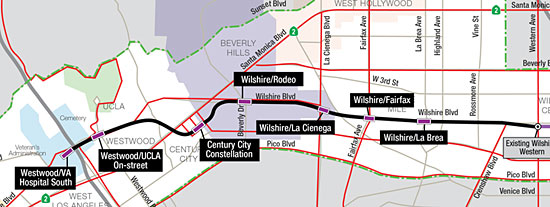
The subway, an extension of the Purple Line, will feature 7 new stations along a 9-mile route. Graphic/Metro
Despite threats of litigation from Beverly Hills, Metro’s board of directors sent the long-anticipated Westside Subway heading down the tracks on a route that includes a controversial station on Constellation Boulevard in Century City.
The Metro board, which had previously approved the subway’s first segment, voted Thursday to give final approval to the line’s second and third phases. When completed, the $5.6 billion subway will extend Metro’s Purple Line from Wilshire and Western to the Veteran’s Administration in West L.A.
“It will be the first mass rapid transportation project for Westwood and Beverly Hills and Century City and the Miracle Mile in history—something that the area has longed for for a very long time,” said Supervisor Zev Yaroslavsky, a member of the Metro board.
The board’s vote came over sharp objections from some Beverly Hills officials, including school board member Lisa Korbatov, who warned: “You’re careening headlong into a lawsuit…I’m telling you here and now: you will not succeed. We will stop you at every turn. You will be litigated.”
Beverly Hills officials have objected to the placement of the Constellation station because plans call for tunneling under the campus of Beverly Hills High School to get there. They argue that such tunneling could pose safety risks and interfere with future development on the school grounds—concerns that Metro says are unfounded.
Thursday’s landmark vote came a week after a special hearing in which Beverly Hills aired its objections to the subway plans, presented the findings of its own scientific consultants, and offered three alternate routes.
But Metro stood by its own experts, and said the Beverly Hills proposals for the alternate routes were not feasible.
Many members of the public showed up to support the project route that included the Constellation station. The first speaker got things going with an exhortation to “dig, baby, dig!”
The board voted 7-2 in favor of the project, with Michael D. Antonovich and John Fasana opposed. The vote clears the way for Metro to seek federal approvals to create final design and engineering plans for the project. Construction could begin as early as next year. Under the current timetable, the first phase of the project from Western Avenue to La Cienega would be completed by 2020, with the line reaching Century City in 2026 and Westwood in 2036. Efforts to accelerate that timetable are underway.
After the vote, Yaroslavsky said he still holds out hope that there can be “a meeting of the minds” between Metro and Beverly Hills.
“It’s a safe project,” Yaroslavsky said. “The people of Beverly Hills and the parents of the school kids in Beverly Hills should rest assured that this can be built without any jeopardy to that school and certainly to the kids in that school.”
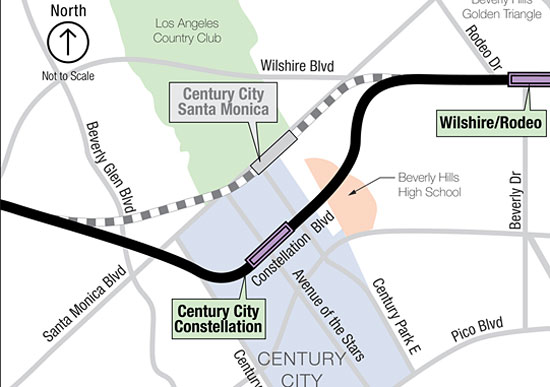
The heavy black line shows the route the subway will take to the Constellation station. Graphic/Metro
Posted 5/24/12
Beverly Hills urges more subway study
May 18, 2012
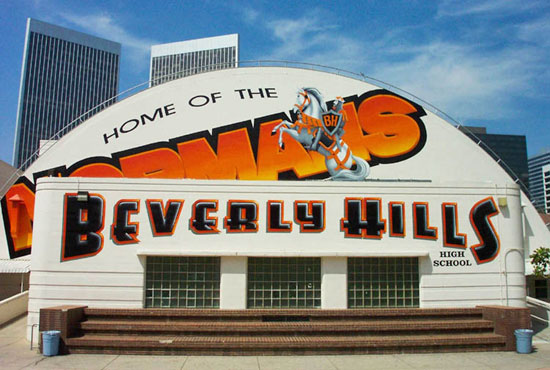
Experts for Beverly Hills say Metro doesn't need to tunnel under the high school to get to Century City.
Scientific experts and lawyers representing the city of Beverly Hills and its school district told the Metro board on Thursday that the agency’s research into placement of a Century City subway station is flawed and inadequate, and urged the board to delay making a final decision until extensive new testing can be performed.
“We implore you to take the time—because you have the time—to make the right choice,” Beverly Hills City Attorney Larry Wiener said toward the end of a special hearing the city had requested under a rarely-used provision of the state Public Utilities Code.
The city has objected to plans to tunnel under Beverly Hills High School in order to build a Century City station at Constellation Boulevard as part of the Westside Subway project, saying it is potentially unsafe for students and would interfere with future campus development.
Metro’s own experts—including noted earthquake authority Lucy Jones, part of an independent review panel that assessed the agency’s findings—say the Constellation location would be safe. They say that an alternate location on Santa Monica Boulevard—which would avoid tunneling under the high school—is unsuitable for a station because of active earthquake faults there.
Beverly Hills’ experts disagreed on a number of key points.
They said there is evidence that earthquake faults along Santa Monica Boulevard are inactive and thus pose no threat. They also contend that Metro has not performed adequate scientific testing and risk analysis to determine whether the Constellation location is safe.
Beverly Hills commissioned its own trenching studies on the high school campus and its experts have produced a series of reports intended to challenge Metro’s findings on the route the subway should take to get to Century City. (The Beverly Hills reports are here; Metro’s responses to the reports are here, along with other scientific and environmental documents.)
On Thursday, Beverly Hills experts testified that their trenching method was more extensive and produced more accurate results than Metro’s method of boring into the earth and taking samples at the high school site. The Beverly Hills experts said they found no earthquake faults on the campus. And they said they found it curious that Metro’s experts, who had determined that there are faults on the campus, changed the mapped location of those faults after reviewing the Beverly Hills findings.
One of the consultants testifying for Beverly Hills, Tim Buresh, said that Metro’s tunneling plans could interfere with future underground development on the high school campus—which prompted some skeptical questions from Supervisor Zev Yaroslavsky, a member of Metro’s board of directors.
“There is no way in the world that the school district is going to build a six-story building underground, is there, Mr. Buresh?” Yaroslavsky asked.
Buresh insisted it was “entirely possible” that the school might eventually do so.
Buresh, a former executive with the California High-Speed Rail Authority, also drew skeptical questions from another Metro director, Richard Katz.
After Buresh told the Metro board that “you don’t gamble with children’s safety, ever—period,” Katz asked him why he had once advocated running a high speed train under another school, Miramar College in San Diego, saying it would have only “insignificant impacts.”
Buresh replied that he left the rail agency before he had a chance to change his position on that, but said he would have ultimately advocated another route that avoided the college.
Other than a handful of questions from the Metro board, the hearing was devoted entirely to speakers representing Beverly Hills.
The Metro board has approved the Westside Subway’s final environmental documents, but has deferred a decision on placement of the Century City station until after the Beverly Hills hearing could be held. The earliest the board could take up the matter would be at its regularly scheduled monthly meeting on May 24.
Toward the end of Thursday’s 3½-hour-long hearing, an attorney representing Beverly Hills, Robert McMurry, presented the Metro board with three alternate routes that he said would make it possible to build a station at Constellation without going under the high school. He urged the Metro board to hold off on any decision about the siting of a Century City station until it can gather more information.
“Now is not the time to make that decision. Otherwise, you’re going to shortchange us, you’re going to subject Metro to greater delays due to litigation and even worse consequences if you lose the litigation,” McMurry said.
Yaroslavsky said the Metro board will consider the experts’ opinions on both sides of the issue before making a final decision.
“All in all, I thought the city and school district of Beverly Hills made a professional presentation. Not surprisingly, their experts’ conclusions are diametrically opposite of Metro’s, so we will have to review the testimony and reconcile the differences before making a final decision on the subway alignment,” Yaroslavsky said. “This is a problem that can be solved, but the hysteria that has characterized some of the debate needs to be dropped. Today was a good start.”
Posted 5/17/12
Subway gets green light, and a detour
April 27, 2012
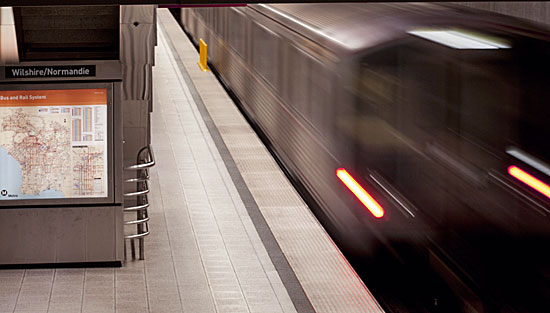
The first phase of the Westside Subway, approved this week, will run from Wilshire and Western to La Cienega.
The decades-old dream of building a subway to the Westside of Los Angeles reached a major milestone this week, with the Metro board’s certification of final environmental documents for the project.
The board also approved station locations for the subway’s 3.9-mile first phase, which will extend the Purple Line subway from Wilshire and Western, with stops at La Brea, Fairfax and La Cienega.
But, responding to recent actions taken by the city of Beverly Hills, the board stopped short of approving the entire 9-mile route ending at the Veterans Administration Medical Center in Westwood. Instead, Metro directors voted to postpone a decision on the subway’s final two segments until a hearing can be held to allow Beverly Hills officials to air their concerns about the proposed placement of a station on Constellation Boulevard in Century City, which would require tunneling under Beverly Hills High School.
Beverly Hills requested the hearing under a seldom-used provision of the state’s Public Utilities Code. After the hearing, to be held within the next 30 days, Metro could take up consideration of the final phases of the subway project.
A standing-room-only crowd packed the Metro board’s hearing room Thursday. Many extolled the subway—and the Constellation Boulevard station location—as a job-creating project and much-needed alternative to the traffic-clogged streets around Westside employment centers.
Hilary Norton, executive director of the group FAST (Fixing Angelenos Stuck in Traffic,) reminded the board that a healthy majority of county voters supported taxing themselves to build the subway and projects like it.
“I am here to say thank you for keeping your promise to the 67% of the county’s voters that came to vote for Measure R in support of the Westside Subway,” she said. “For all of us who are parents, who have children and are coming here from these areas outside the study area and need a subway, we ask for your support today.”
But a series of speakers from Beverly Hills said they are worried about the safety of tunneling under the high school property, and about the potential impact on future development plans on the campus. Many said they support placing the Century City station instead on Santa Monica Boulevard—a location that Metro’s scientific experts, including noted seismologist Lucy Jones, say is too dangerous because of active earthquake faults there.
Lisa Korbatov of the Beverly Hills Unified School District Board of Education, a vocal opponent of tunneling under the high school, urged the Metro directors Thursday to closely read reports by experts hired by Beverly Hills. She said it is still possible to “press the re-start button” and reach common ground.
“Let’s have dialogue, open, meaningful, comprehensive communication, and let’s all read the science,” she said.
Added Beverly Hills council member Barry Brucker: “We only ask that science, all the science available, determine the real safety risks and construction challenges, and guide all the important decisions of the Westside extension.”
But Supervisor Zev Yaroslavsky, a member of Metro’s board of directors, said that Beverly Hills’ scientific experts came to “largely the same conclusions that we did—cautioning that we need to be careful and we need to do it right. And we ought to be careful and we ought to do it right.”
“No member of this board of the MTA would want to build a tunnel under any building or under any home in any part of the county of Los Angeles that wasn’t safe,” he added. “But if it’s safe in one part of the county of Los Angeles, it’s safe in every part of the county of Los Angeles.”
Yaroslavsky said he also holds out hope that “problem-solvers” on both sides can get together and work things out, particularly when it comes to making sure that Metro’s plans don’t interfere with future development on the high school campus.
“There is room to talk,” he said, “and there is room to make this work for everyone concerned.”
The Metro board voted 11-1-1 to approve the environmental report and first phase of the subway, with Supervisor Michael D. Antonovich voting no and Supervisor Mark Ridley-Thomas abstaining. Phase one of the subway is expected to break ground next year and to be completed by 2020, although efforts are underway to accelerate that timetable.
Posted 4/26/12
Expo wins again in court
April 18, 2012
As the first segment of the Expo Line gets ready to roll later this month, the light rail’s second leg, to Santa Monica, received an important green light this week from a state appeals court, which rejected a challenge to the project’s environmental review process.
The court found that the review was properly conducted to assess the project’s impact on future traffic and air quality. The ruling marks the second rebuff of a legal challenge to the project that was filed by the homeowners’ group Neighbors for Smart Rail. The group filed suit in 2010, but a Los Angeles Superior Court judge rejected its argument last year.
The group had contended that the Exposition Metro Line Construction Authority improperly based its environmental review on projected 2030 conditions instead of using 2009 conditions as a baseline. The group said previous court cases involving projects inSunnyvaleandMaderahad disallowed the use of such hypothetical projections.
But the appeals court said those cases did not apply to Expo.
“In our review of the record, we found the Expo Authority’s use of 2030 projections is supported by both substantial evidence and common sense,” the court said in its opinion.
The court said that it was impractical to look at current conditions in trying to assess how the project would affect traffic and air quality.
“As a major transportation infrastructure project that will not even begin to operate until 2015 at the earliest, its impact on presently existing traffic and air quality conditions will yield no practical information to decision makers or the public,” the court said. “Many people who live in neighborhoods near the proposed light rail line may wish things would stay the same, but no one can stop change.”
Terri Tippitt, president of Neighbors for Smart Rail, said that the court’s ruling is in direct conflict with decisions handed down by other state appeals courts, and her group is planning another appeal.
“The California Supreme Court needs to review and decide what the law is,” she said in a brief statement.
But Expo CEO Rick Thorpe hailed the decision. “The appellate court decision allows us to move forward without delay to this much needed project,” he said. “This is great news for improving mobility on the Westside of L.A.”
Posted 4/18/12
Searching for CicLAvia’s slow gear
April 11, 2012
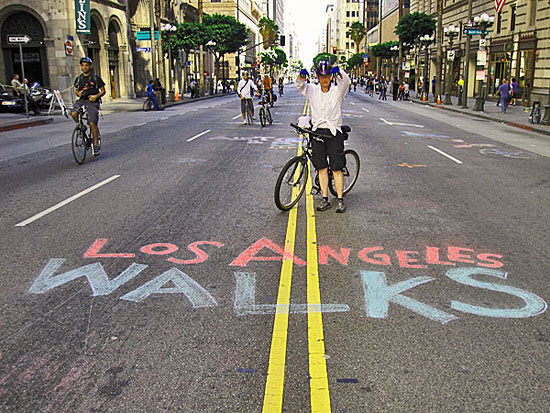
As pedestrians make their mark on CicLAvia, organizers urge cyclists to slow down and share the route.
If you go to CicLAvia this weekend, keep an eye out for Deborah Murphy.
She’ll be the one walking down the middle of the street with her Jack Russell terrier puppy, sharing her mantra with the sea of bicyclists around her:
“Slow down. Look around. Meet someone.”
Murphy, one of Los Angeles’ foremost pedestrian advocates, has walked in all three CicLAvias since the car-free street festival started here in 2010. She hopes that when the fourth gets underway at 10 a.m. on Sunday, April 15, she’ll see evidence that her message is gaining traction with the cyclists who make up 80% to 90% of the crowd.
“I want to believe it’s getting better,” said Murphy, founder of the advocacy group Los Angeles Walks and chair of the city’s Pedestrian Advisory Committee, who said she was alarmed the first time out by cyclists zooming downhill at one point along the route (where a “mandatory dismount” rule is now in effect.) “That’s not what CicLAvia’s about…This is a street party. This is not a street race.”
That sentiment is seconded by Josef Bray-Ali, the owner of the Flying Pigeon bike shop, who wrote a much-discussed blog post last April about taking his young daughter out on the route.
“This was the first time our 3-year old daughter had a chance to ride her bike in the street. The magic of that moment was ruined by CicLAvia participants on their bicycles riding by us on the left and right (while we were on the right hand shoulder of the street) going, frankly, too darn fast,” Bray-Ali wrote. “It is a perversion of the spirit of CicLAvia that the entire course is turned over to the fastest mode on the road…Let’s get this day right, Los Angeles!”
In other words, whose CicLAvia is it anyway? As the still-young event grows and changes, its identity is evolving as well—with a large and vocal cycling population reveling in having its own five-hour, 10-mile stretch of nirvana in an otherwise car-dominated metropolis, while an equally passionate walking community stands eager to claim its place on the pavement, too. The challenge of striking a balance stands as the price of success as CicLAvia comes of age.
With organizers expecting their biggest crowd of more than 100,000 on Sunday, such growing pains are proving somewhat ironic for the influential bicycle enthusiasts who started CicLAvia and view it as a key achievement in Los Angeles’ bike evolution.
“Every day of the week, we feel disrespected by cars. Let’s not be the oppressors,” said Joe Linton, a fulltime CicLAvia consultant and longtime L.A. cycling advocate. While he said that “99.9% of people have a great time at CicLAvia, whether they’re walking or biking, or 4 years old or 80 years old or 22 years old,” he said all participants need to bring mutual respect, common sense and a willingness to engage with each other.
“Everybody’s in this together,” he said. “Everybody needs to watch out.”
That said, cyclists’ passion for CicLAvia is so strong that it may tend to block out the possibilities for other ways to participate.
“We love that it’s an awesome bike event. There’s a sense that it’s so wonderfully ‘bike-y’ that people don’t realize they can do it in other ways,” Linton said. “We definitely are concerned about being inclusive.”
Pedestrians are welcome anywhere along the route, but first-timers might be especially comfortable strolling along Spring Street, Linton suggested. “It just feels really different. It’s quiet, you can see the architecture.” (Speaking of which, a new guide showcases the architectural and design high points all along the CicLAvia route.)
For novice cyclists, Linton has this advice: “Don’t bike all five hours. Stop for lunch. Don’t think of it as a workout; think of it as an exploration.”
The Los Angeles County Bicycle Coalition this week posted its own series of cyclist tips for riding safely and keeping an eye out for others.
Organizers say that the more CicLAvia becomes a street festival—with frequent musical, culinary and entertainment distractions—the slower the pace and the better for participants of all ages and experience levels.
So a key part of CicLAvia’s evolution has been to encourage dodge ball games, giant chess sets and movable photo booths, as well as musical acts and other spontaneous diversions along the route. REI will be sponsoring a climbing wall at the Hollenbeck Park hub, while the African American Firefighter Museum Hub on Central Avenue will feature museum tours, musical performances and a bike show starring the Real Rydaz Lowrider Bike Club.
Downtown, the Nature Conservancy will be raffling off two Schwinn-donated beach cruisers at 7th and Figueroa. It’s one of the organizations (others range from the Asian Pacific American Legal Center to the car-sharing service Zipcar) that will be “adopting” intersections and helping to manage bike-and-pedestrian flow through intersections which cars will be allowed to traverse intermittently. The groups will also be spreading their messages—an opportunity not lost on Los Angeles Walks, which has adopted 7th and Broadway.
The idea is to create an “intersection celebrating pedestrians,” L.A. Walks steering committee member Alissa Walker said in an email. On tap: “Lots of foot-friendly activity including double-dutch jump rope and hula hooping.” (Those inspired to help the group advance its pedestrian-friendly mission can do so even after CicLAvia is over by attending L.A. Walks’ karaoke fundraiser at Atwater Crossing on Saturday, April 21.)
Walker, a cyclist, pedestrian and blogger at Gelatobaby, concedes that she, too, was “a bit intimidated by all the bikes at previous CicLAvias.”
“But I think the best thing we can do is show all the different ways that streets can be used,” she said, such as a book club discussion she helped organize with L.A. Times architecture critic Christopher Hawthorne beside the 110 Freeway during last April’s CicLAvia.
This time out, she suggests pushing the envelope even further: “Grab some food to go and put a blanket out on the street.”
That’s right out of the playbook recommended by Flying Pigeon owner Bray-Ali, who blogged about the speeding cyclists last year. He thinks the best way to make CicLAvia evolve to become more inclusive is to harness more corporate sponsors to create crowd-pleasing digressions along the route and to find ways to make local merchants love it as much as the cyclists do. “Bring your bike and your wallet,” he suggests.
“It’s going to take work to make it work for pedestrians and people in walkers and wheelchairs, especially on the business side of things,” he said. “But that’s really when the power of the event takes over.”
And as CicLAvia grows, so do its participants, like Bray-Ali’s daughter, who’s now a road-tested CicLAvia veteran on a kiddie bike.
“Now she’s four, and she hauls,” he laughed. “Her bike is too slow for her.”
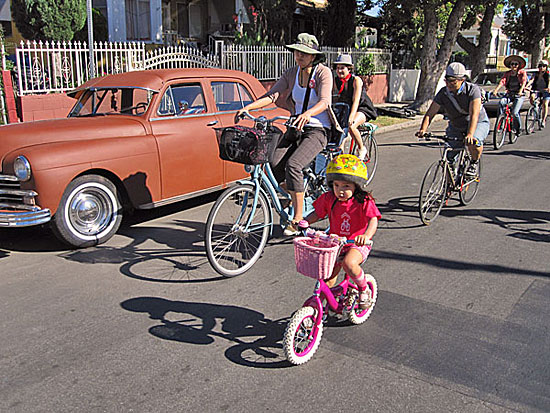
Valentina Bray-Ali leads the way to CicLAvia from her dad's Flying Pigeon bike shop. Photo/ubrayj02 via Flickr
Posted 4/10/12
Eating it up on the Expo Line
March 28, 2012
They dubbed it the Pastrami Express. When the Red Line subway came to Langer’s MacArthur Park neighborhood in 1994, offering a convenient way for downtown workers to get their pastrami-on-rye fix, it touched off a transit-driven boom for the legendary delicatessen, family-owned since 1947.
After an inaugural weekend of free rides on the new subway, deli owner Norm Langer showed up Monday and was met with a miraculous sight: customers, by the hundreds.
“I had 500 people on a waiting list,” he recalled. It was a welcome turnaround for a business suffering at the time from demographic shifts and high crime in the neighborhood. “My light at the end of the tunnel was the Red Line,” he said. “If it didn’t open, we would have closed.”
Today, business is better than ever in a revitalized neighborhood, Langer said, continuing to marvel at the Red Line effect. “It’s phenomenal. And it gets better over the years because there are more lines that tie into it. We’ve had a great resurgence of our customer base because of it.”
Now a new generation of restaurateurs, business owners and cultural institutions is looking to another much-anticipated public transit project—the Expo Line—and hoping that the gravy train will soon be pulling up to their establishments, too.
Make that the chili, hot dog, fresh fish and cobbler train.
Earlez Grille is among those preparing for an influx of newcomers when the first Expo trains roll out on April 28.
“It’s a great thing,” said Cary Earle, who owns the establishment with his brother Duane and mother Hildred. The Grille’s location—beside the Crenshaw station and a few stops away from the University of Southern California—is prime, he said. “It’s going to give us a lot of USC students.”
First-time visitors should try the basics, he said: a beef hot dog with mustard and cooked onions, washed down with a Playa’s punch, a non-alcoholic mixture of red fruit drink and lemonade.
The restaurant, on the former site of Jack’s Chili Factory, also specializes in chili made from Jack’s original recipes. On a recent Expo Line test run for the media and elected officials, Metro CEO Art Leahy said he’s looking forward to eating there once Expo opens. “It will now be a hot downtown lunch spot,” he predicted.
Another potential hot spot is Mel’s Fish Shack on Jefferson Boulevard, a short walk from Expo’s Farmdale station, which is slated to open later in the spring, after the initial rollout.
“I pray that it will bring us a windfall of customers,” owner Georgette Powell said, sitting at the counter of her tiny eatery, where cooks like Jerry Rhodes fry up corn flour-dusted catfish, snapper and shrimp along with healthy innovations such as grilled salmon salad and tilapia wrap with dill sauce.
“I have felt isolated for many years” in terms of the accessibility of her location, said Powell, 44, who learned the business from her late father, Mel. “The train makes us more desirable.” Powell hopes eventually to expand Mel’s to other locations and perhaps start a community-based culinary school to train aspiring cooks in the “healthy soul food niche.”
Some, however, are skeptical about the train’s ability to deliver new customers.
“Will anybody walk over two blocks, when they’re traveling from Point A to Point B? I don’t think so,” said Carolyn McMillan, co-owner of The Kobbler King on Jefferson, near the Crenshaw station. Those who do make the trip, however, should try one of the savory cobblers like chicken or seafood, she said, with berry cobbler for dessert. “Peach and apple are good, don’t get me wrong, but I like the berries,” she said.
Initially, the Expo Line will travel between Metro’s 7th Street Center downtown and La Cienega/Jefferson. Some of its marquee destinations are big, internationally known venues—Staples Center, USC, the county Natural History Museum, the Coliseum. The California Science Center is expecting a “significant increase” in attendance, buoyed in part by the Expo Line and also by anticipated blockbuster shows devoted to Cleopatra, and, later, the Space Shuttle Endeavour.
But smaller venues, like the Lula Washington Dance Theatre near the Crenshaw station, are also hoping for a boost in visibility. “The main impact is that people will go by our place and see us,” said Executive Director Erwin Washington, who noted that many of the troupe’s dancers and students will also have an easier time getting to the theatre on the Expo Line.
At the California African American Museum, served by the new line’s Expo Park/USC station, director Charmaine Jefferson said staff at the admission-free museum would also have a better commute to work. In addition, having a light rail option should help overcome one of the major downsides of its location near the Coliseum: patrons who stay away on sporting event game days. “You’ll have guests who’ll say, it’s going to be a zoo; I don’t want to go there,” she said.
The rollout of the first phase of the Expo Line will culminate with the opening of the Culver City station at Venice and Robertson, expected this summer.
At Culver City’s quirky Museum of Jurassic Technology, archivist and administrator Hana van der Steur said the train will be a benefit for current visitors and supporters—as well as those who have yet to discover the collection of oddities and treasures.
“We’re basically ecstatic to have it,” she said. “We’re really hoping that people will take advantage of it. The museum is the kind of place that you really have to visit in order to get a good sense of it.”
Among owners of Culver City’s many eateries, there’s some uncertainty about what the station opening will mean for the area, already known as a dining destination for many on the Westside, said Ken Kaufman, the owner of Rush Street and City Tavern, who also serves on the board of the Culver City Downtown Business Association.
“We’re not sure of it. We know that the culture of L.A. is a car culture, and we don’t know how quickly people will adapt to using the train,” he said. “We don’t expect it to have a significant effect, but we hope we’re wrong.” He said a much bigger impact is expected four years from now—when Expo Phase 2 opens from Culver City to Santa Monica, giving traffic-challenged Santa Monicans a quicker route to dinner.
“As someone who takes reservations,” he said, “everybody knows that people who come from Santa Monica are always a half hour late.”
For a sampling of other attractions along the Expo Line route, check out Metro’s Destination Guide.
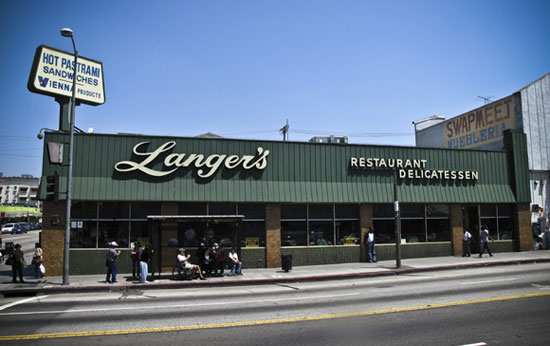
Langer's Deli says the Red Line saved its business in the days of high crime in the MacArthur Park neighborhood.
Posted 3/29/12
Subway makes tracks toward Westwood
March 23, 2012
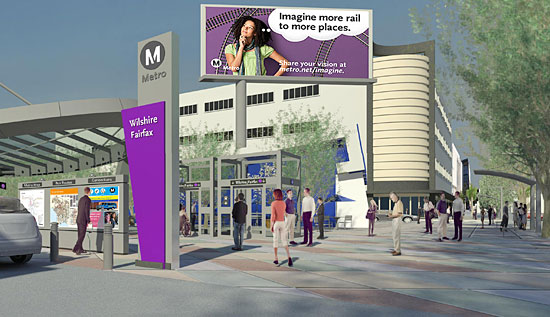
The subway's 7 proposed stations, most along Wilshire, could look something like this, at Fairfax near LACMA.
Metro officials today unveiled final environmental documents for the Westside Subway, detailing a 9-mile extension of the existing Purple Line subway with seven recommended stops, including a Century City station at Constellation Boulevard and Avenue of the Stars—a location approved by a panel of top scientists but hotly contested by some officials in Beverly Hills.
The release of the final environmental reports marks a significant milestone for the project, which has been in the planning stages for more than four years. When completed, the subway is expected to log 78,000 trips a day and make it possible to travel from downtown L.A. to Westwood in 25 minutes.
While the project will benefit riders throughout the region, its impact will be felt most strongly on the Westside, which has a heavy concentration of jobs along with some of the worst traffic in the nation.
“This is a project that Los Angeles has been talking about for at least a half a century,” said Jody Litvak, Metro regional communications manager. She called the release of final environmental documents “a huge accomplishment” and a “delivery to voters on the promises of Measure R,” the ½-cent sales tax that will partially fund the subway.
The Westside Subway would begin where the Purple Line currently ends, at Wilshire and Western. The new stations would be located along Wilshire at La Brea, Fairfax, La Cienega and Rodeo Drive, as well as in Century City, at UCLA and at the V.A. Hospital.
The siting of the Century City station has been controversial. Because the route to get to the proposed Constellation station would pass under the Beverly Hills High School campus, some city officials have raised safety concerns about tunneling in the area and urged that the Century City station be built instead under Santa Monica Boulevard.
But last year, a panel of high-profile scientific experts convened by Metro said that active earthquake faults make the Santa Monica Boulevard location too dangerous for a subway station. These experts, including Lucy Jones of the U.S. Geological Survey and Caltech, found instead that a station could be safely built at the Constellation site, which has no evidence of active faults. In addition, they said that tunneling under the high school property could be accomplished safely with state-of-the-art equipment and techniques even through earthquake zones and ground with large concentrations of methane gas.
Beverly Hills hired experts of its own to review Metro’s scientific conclusions. Those experts argue that more research is needed, particularly around the Constellation site and on the high school campus. (The city’s website has links to those reports, as well as other information on Beverly Hills’ position on the subway.) In addition, the Beverly Hills school board recently commissioned widespread trenching studies on the high school campus to determine whether seismic hazards are present; a report on that is expected soon.
Metro officials say the final environmental documents released today make it clear that it will be safe to build a subway station at Constellation, but said they will be studying the Beverly Hills reports carefully. (Updated: The Beverly Hills School District’s attorney, Kevin Brogan, issued a statement criticizing Metro for releasing the final environmental documents before receiving the results of the trenching studies. His statement is here.)
Agency officials said the Constellation station also would attract more riders and be closer to more jobs than the Santa Monica Boulevard station. The agency projects 8,600 boardings at Constellation each weekday, compared to 5,500 boardings at Santa Monica Boulevard.
The final environmental reports also studied various alternatives for the two stations in Westwood. For the UCLA station, the report recommends a location on Wilshire at Westwood Boulevard. At the V.A. Hospital, it recommends building the station on the south side of Wilshire at Bonsall Avenue, in the northern edge of the hospital’s parking lot just west of the 405 Freeway.
Plans call for the subway to get to Wilshire and La Cienega by 2020, to Century City by 2026 and to the Westwood V.A. Hospital by 2036. However, some officials, including Metro Board Chair and Los Angeles Mayor Antonio Villaraigosa, are pressing for the entire project to be completed much sooner—by 2022—under an accelerated building program known as America Fast Forward.
Metro has estimated the cost of the project at $5.66 billion in 2022 dollars, but that could rise to an estimated $6.29 billion if the project takes until 2036 to complete. Some funding will come from Measure R but more will be needed from the federal government’s “New Starts” program.
The final environmental documents are scheduled to go before Metro’s Board of Directors on April 26. If the board votes to certify the project, the Federal Transit Administration will be asked to sign off on the plans and formally conclude the federal environmental review phase of the project. Then, final design work is expected to take about a year, with groundbreaking slated for sometime in 2013.
A series of informal community open houses are scheduled next week so that people can learn more about the project and see artists’ renderings of what some of the stations could look like. They will be held on Monday, March 26, at the Los Angeles County Museum of Art; on Wednesday, March 28, at Westwood United Methodist Church; and on Thursday, March 29, at Temple Emanuel in Beverly Hills. Each of the meetings will run from 5 p.m. to 7:30 p.m. Additional details and parking information are here.
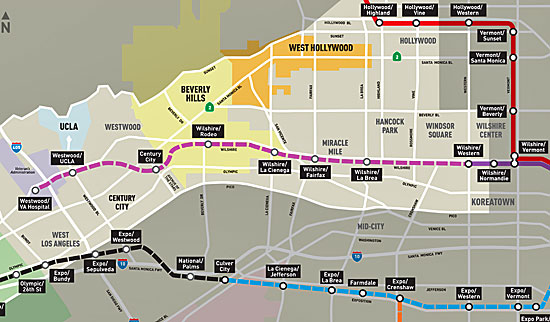
The 9-mile extension of the Purple Line starts at Wilshire and Western and ends at the VA Hospital in Westwood.
Posted 3/19/12
Sisterhood of the traveling bikes
February 7, 2012

The movement to increase the number of women cyclists on L.A. streets includes Andrea Denike Martinez.
Andrea Denike Martinez still remembers the day she got back in the saddle.
It was Earth Day—April 22, 2010. For the first time since a bad bicycle accident fractured her skull and landed her in intensive care several years earlier, Martinez was ready to once again brave L.A.’s streets on two wheels.
Heading out from her Echo Park home, she was pumped up with environmental commitment—and “so nervous,” she recalled.
But moral support was also on the road that day. “I met another girl on a bike going that very same route.” She was a total stranger, but Katherine Gladwin was going in the same direction so they rode together to their jobs near Wilshire and Western.
They not only became fast friends, but started a small women’s cycling crew they dubbed the Bodacious Bike Babes. Since that first commute, they’ve organized and publicized group rides, volunteered at events like CicLAvia, and generally tried to encourage other women to take the plunge into an L.A. cycling world that remains overwhelmingly dominated by men.
Even though they may have felt alone out there at times, Martinez and Gladwin have plenty of company these days. On Wednesday, February 8, a coalition of women cycling advocates is set to gather in Long Beach to announce an ambitious goal: doubling the number of female bicyclists on Southern California streets within five years.
The initiative is led by a relatively new organization, Women on Bikes SoCal, which seeks to promote the “joy, beauty and benefits of bicycling for women.” Its campaign includes establishing the nation’s first women-only scholarship program for League Certified Bike Safety Instructors. (Information on supporting the initiative is here.)
One of the most visible faces of female cycling in Southern California, Long Beach Vice Mayor Suja Lowenthal, is among those backing the movement.
On a recent bicycle tour of her city, which is noted for its large and growing network of bike-friendly amenities, Lowenthal made it clear that dressing like Lance Armstrong—and riding like a Tour de France champion—are not required to join the cycling revolution.
“I want to wear my heels. I want to do all sorts of kinds of things that are about regular lifestyle,” Lowenthal said. “You don’t have to be the 50-mile-a-week spandex athlete. You can move about with your children and make it a very family-oriented, healthy, active lifestyle.”
In fact, Lowenthal thinks that the health and well-being of kids can be a powerful motivator in getting women to take up cycling. Childhood obesity is a “crisis of epic proportions,” she said, and there’s nothing like getting mothers on bikes to get everyone else onboard, too. “It is that green light: ‘Well, Mom’s OK with it,’ “ she said.
Still, if current statistics are any indication, there may be an uphill climb ahead.
The Los Angeles County Bicycle Coalition reports that only 16% of cyclists spotted during last year’s bicycle count were women—about the same percentage as in the previous count in 2009. A new report by the national advocacy group Alliance for Biking and Walking found that only 20% of those bicycling to work in Los Angeles are women—compared to 33% in Sacramento, 38% in Portland and a remarkable 49% in Memphis.
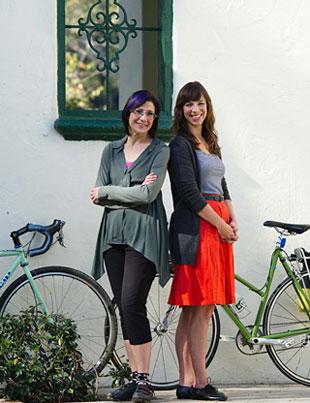
Jennifer Klausner, left, and Alexis Lantz of L.A. County Bicycle Coalition. Photo by Allan Crawford/Women on Bikes SoCal
Ask L.A. women cyclists, non-cyclists and would-be cyclists about the imbalance, and most are quick to sum up the problem in two words: too dangerous.
“A lot of it is people really are deathly afraid of cars, and the way people drive,” said Martinez, 33, co-founder of the Bodacious Bike Babes.
“It’s just too stressful being on the road,” added Kristen Schwarz, 28, who lives in East Hollywood and gave up her bicycle a couple of years ago after one too many encounters with speeding motorists. “It’s tough out there!”
Everyone, it seems, has a harrowing story or two.
“My first experiences in L.A. were pretty terrifying. I went down Wilshire. It was definitely a treacherous route,” said Gladwin, Martinez’s friend and co-founder. “My bicycling career in Los Angeles started in a pretty daunting fashion.”
She’s been struck twice by cars, the first time by a morning rush hour driver who mowed her down on Wilshire. “She stopped and she actually was complaining about heart palpitations because of the trauma she had experienced,” said Gladwin, 29, who was thrown to her knees in the collision. “I was intimidated but I wasn’t going to let that deter me.”
Magdalena Paluch, who interviewed women cyclists as part of a project to create a bicycling app while she earned her master’s degree in industrial design at Pasadena’s Art Center College of Design, said greater female involvement could lead to big things.
“I feel strongly that if anything will change, most of the time it changes because of the women. We are change agents,” she said. “Women are considered an ‘indicator species’ for biking and public transit because women are risk-averse. If you make it safe for women to bike, it’ll be safer for everybody.”
Cycling advocates agree. They say that creating more, and safer, facilities like “protected bike lanes”—in which riders are buffered from car traffic—and “bicycle boulevards” on slower-moving residential streets is the key to overcoming the perception and reality of dangerous L.A. streets.
Joe Linton, a CicLAvia consultant and longtime L.A. bicycle activist, noted that the gender disparity disappears in countries like the Netherlands, which has a highly developed network of bikeways and a culture in which cycling is considered a safe and commonplace way to get around.
“In very bicycle-safe cultures, women are actually the majority. In daredevil places, or places that are perceived as daredevil, like L.A., women are reluctant, and reluctant to go with kids,” Linton said. In Los Angeles, where men have long dominated the bike scene, it’s easy for experienced, hardcore cyclists to forget how women—and other less confident beginning riders—may view the challenges of the road, he said.
Advocates are increasingly pointing to women riders’ safety concerns as a way of advancing a broader agenda of making streets better for all cyclists and pedestrians, of all ages. “This is a growing issue,” said Alexis Lantz, planning and policy director for the Los Angeles County Bicycle Coalition.
In fact, the women’s safety argument has been made as part of a push for improvements in Los Angeles County’s Bicycle Master Plan, set to come before the Board of Supervisors in the weeks ahead.
Lantz said it also could be a factor as advocates press for more bicycle resources in the Southern California Association of Governments’ Regional Transportation Plan. And, on the federal level, she said, “Safe Routes to School” funding—which provides resources for many bicycle and pedestrian programs and is now threatened as part of the budget showdown in Washington—is another area in which women’s street safety concerns are a big part of the conversation.
Beyond the public policy arena, signs are everywhere that women are finally starting to make their move into the bike lane—at least a little bit.
Photos of bike-riding celebs like Zoe Deschanel, Hilary Duff and Vanessa Hudgens are all over the Internet, as are fashion-forward blogs such as Los Angeles Cycle Chic. Monday nights are reserved for women at the Bicycle Kitchen. Although nobody’s done a formal count, popular street-closing CicLAvia events seem to be bringing out large numbers of women. And young female activists are creating crews like Iron Unicorns, dedicated to creating “equality for women cyclists, both on the streets and in society.”
All those are valuable in building the women’s cycling movement, Lantz said.
“I think there is something that everyone can bring,” she said. “Cycle chic is a really great way of promoting cycling for some women. I really think that the more attention brought to cycling, the better.”
Posted 2/7/12




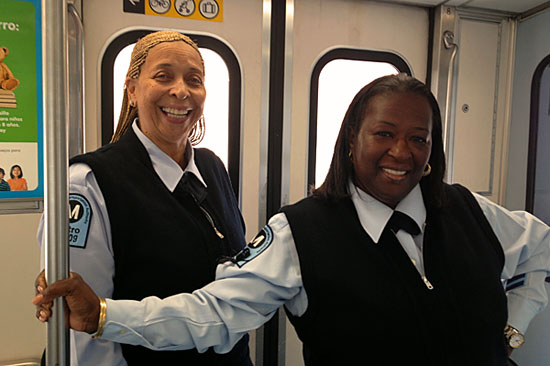
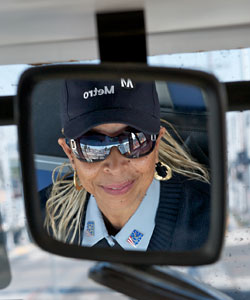
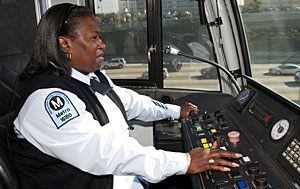
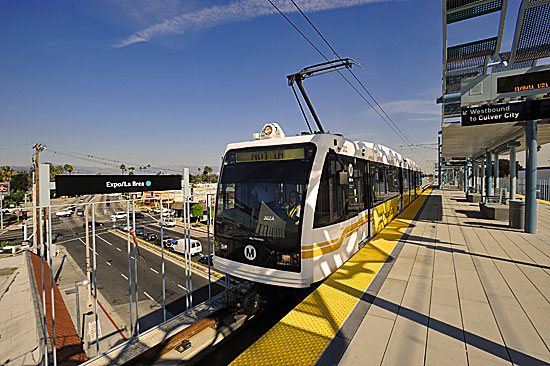
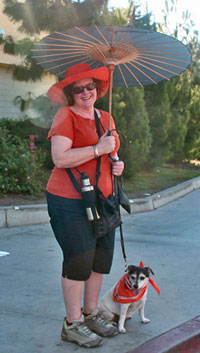
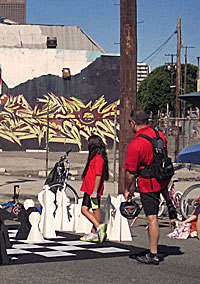
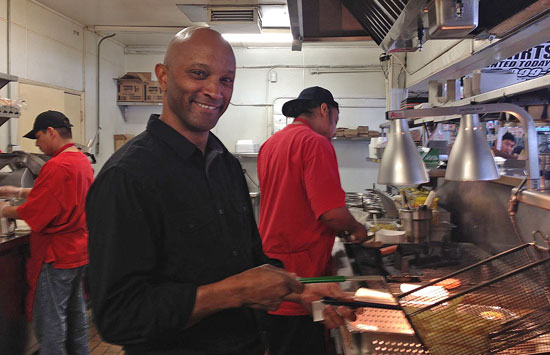
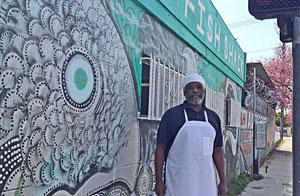
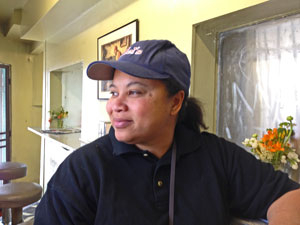
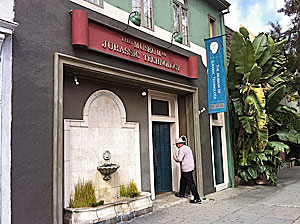
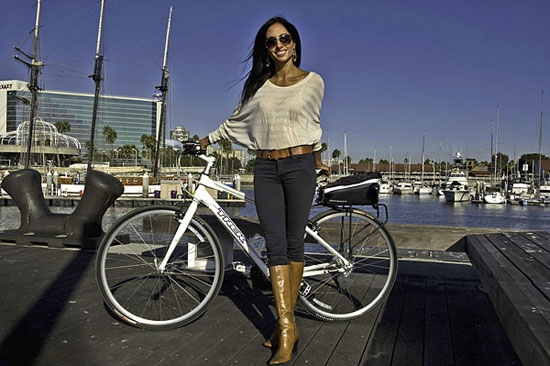







 405 bridge work causes a stink
405 bridge work causes a stink

